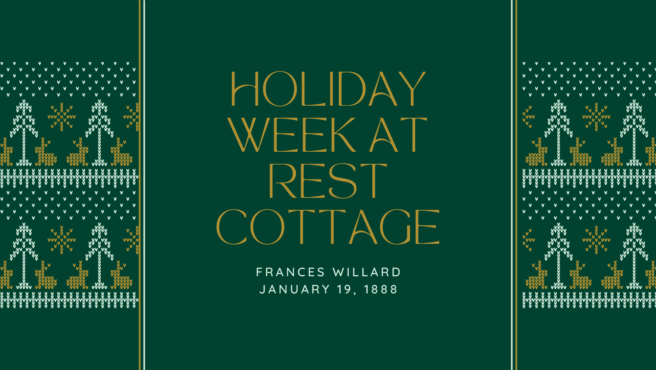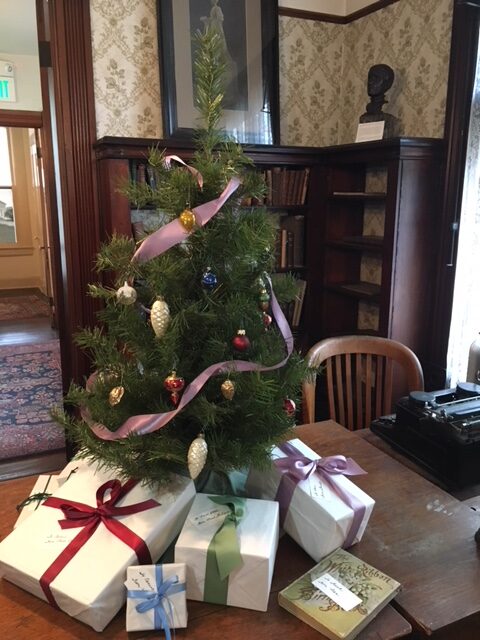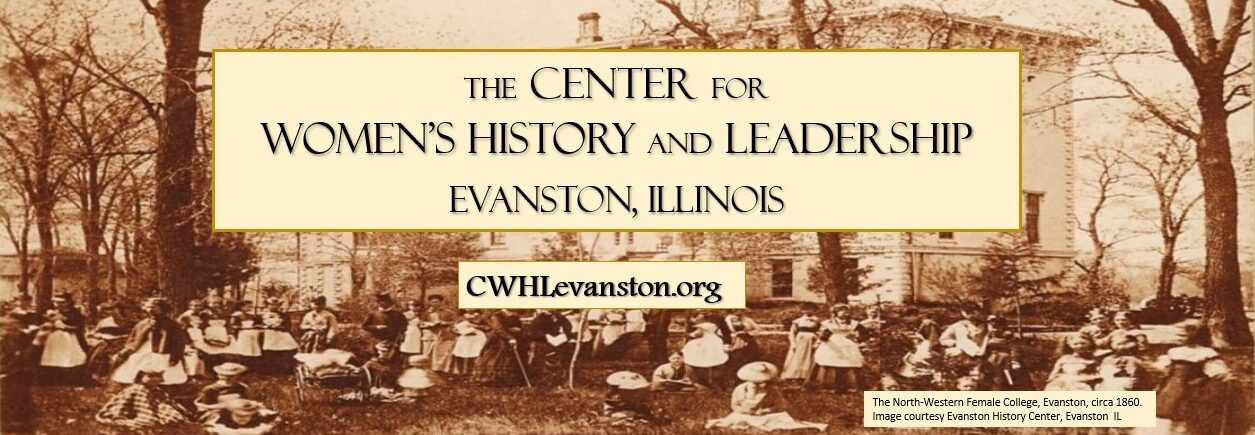
“How strange it seems with so much gone
Of life and love, to still live on.”
Eighty-three Christmases have come to mother, and forty-eight to me. We have sped along the mile posts of years beyond our nearest comrades and are still here, but
“They recon not by months and years
Where these have gone to dwell.”
Of the “Happy Five” two of us linger with the minority, and though no longer jovial-hearted, we are blessedly content to await the unfolding of time and of eternity. Now that dear “Mary B.” and her daughters are over sea, we have in the “Annex” whose doors open into our own home, such pleasant neighbors as Helen Hood, our corresponding secretary, Illinois W.C.T.U.; Julia Ames, associate editor of THE UNION SIGNAL; Ruby Gilbert, business woman of the W.T.P.A. [Woman’s Temperance Publishing Association]; Alice Briggs, my office secretary; and Florence Lancaster, a cousin to Miss Ames, and a sweet stager of our Israel; while only three doors off is Carrie Mitchell, my stenographer, who has become a stand-by of great value. Besides these we have two Christian Swede girls who are at the head of the interior department, and sisters with us of like precious faith. That Anna Gordon beside me is the Rest Cottage balance wheel, goes without saying, so here we are in good heart for a week of holidays—hypothetically at least, though the fact is that except for a day or so, we have worked like beavers, just because we are settled to it, that how to leave off “we find not.” Some of our eleven women sped out for a day or so to see friends and relatives, but in the main we have stayed by the stuff, behind our fortress of elms and evergreens.

All the “pretty things” were displayed on the large library table over in the “Annex,” beside which my brother and his wife were wont to sit in days of auld lang syne. Mother and I were up in my “Den,” when we heard bells ringing, a drum (belonging to Anna’s Loyal Legion) beating for dear life, with triangle thrown in, and going down-stairs we found our folks marching through the halls in procession, with Miss Hood at the head, while Anna, decked out with every temperance pin and badge in the house, wearing the World’s emblem, a bunch of (artificial) water lilies in her hair, and a white bow grown to a sash, around her waist, was acting as marshal of the day. She was resplendent with the glittering emblems of the great cause from the crank pin to the beautiful cross and ribbon badge of British women given to me by Margaret Bright Lucas; but, most conspicuous of all, she wore the ribbon of the Loyal Temperance Legion, to which she is devoted. When we were all assembled, Miss Hood called off the cards that revealed “what was what” upon the groaning table. Mary Woodbridge’s exquisite set of table mats, embroidered “en route,” for mother, was her most notable gift; and mine, an exquisite terra cotta group by Thorwaldsen, Mrs. Carse’s gift, and Lippincott’s Pronouncing Biographical Dictionary—so long desired—from Mother; a lovely marble eight-day clock, with tone like monastery bells, from my accomplished stenographer, Caroline Mitchell; her charming Birthday Book from Anna, and a Novelty in satin, showing two ships and a light-house, from Mrs. Judge East of Nashville. (We say they are Mrs. Meriwether’s “Ship of Prohibition,” and the life boat of “Woman’s Ballot” making for the port of victory.)
After refreshments, we agreed to have a “White Ribbon Class Meeting,” and beginning with our home queen, otherwise “Saint Courageous,” [Mrs. Willard] we told what was the very first approach made by the Temperance Reform to each of us. Mother said is was when Gen. Riley of Rochester, came to her schoolhouse, certainly fifty-seven years ago, made a speech and offered the pledge, which she signed at once, though much laughed at for so doing. Anna said it was in the Congregational Church of Auburndale, near Boston, which she joined when twelve years old, and where a temperance meeting was held by a lecturer who explained the “Black Valley Railroad.” She was so wrought upon, that she set at work and collected the money to buy a small copy of that somewhat lurid work of casuistic art. Miss Hood “came out” in Milwaukee, her home, as secretary of their crusade movement in 1874; Miss Ames in the same movement in Streator, Ill., her home, alongside of Mrs. L.H. Plumb, since so well known in our work; Miss Gilbert gave me great comfort by declaring that a lecture of mine in Freeport, where she was writing in the county clerk’s office, determined her to enter the white ribbon army. Alice Briggs “never knew anything else;” was vice president of her district for years, and a delegate to Detroit convention; is now associate superintendent of national press department, and a dyed in the wool “temperance.” Carrie Mitchell, little Episcopalian that she has been, declared off from the use of wine since she became a Rest Cottager, etc., etc.
We repeated in concert our blessed “Crusade Psalm” (146th), sang one of the white ribboner’s favorites, “How firm a foundation,” and closed the sweet evening with earnest prayer to God. Our Christmas was brightened by the presence of Rev. Anna Howard Shaw of Boston, who is so truly a sister beloved, that she seemed a part of our home, and we could hardly realize this as her first visit. We hope ere long she will be a neighbor of ours, to say the least, for she is coming West.
On Christmas night I spoke in the beautiful new “Hemenway M.E. Church” in South Evanston. It was a token of aggressive spirit of Christianity, that this first service after the dedication should have been dedicated to temperance. Church prayer meeting, W.C.T.U. gospel meeting (kept up now for eight years every Sunday afternoon), and the meeting for election of Directors for Mrs. Carse’s great building enterprise formed the only variations from steady pen work at our desks during holiday week.
Notes:
Frances Willard wrote this as part of her series of small articles about life and work at her home, which she nicknamed Rest Cottage. It was published in the weekly newspaper of the WCTU, the Union Signal, and reflects on her Christmas holiday (if you can call it that with all the work she describes) in 1887. Throughout, Willard scatters references to things that would be familiar to WCTU readers, but may not be familiar to readers today. Here are some of them:
- Willard mentions that she and her mother are the only ones left of the “Happy Five” of her family – Willard’s father, sister and brother had all died by 1887. “Dear Mary B” and her daughters are Willard’s brother’s wife and two daughters – and they lived in the north annex of the house until 1887 when they moved to Germany.
- The Willard’s always employed a few young women (often from Sweden) who managed the cooking and cleaning – in Willard’s words “the interior department.”
- She mentions that she was excited to receive Lippincott’s Pronouncing Biographical Dictionary as a gift. This rather large volume was a commonly used source for anyone (like Willard) who was a public speaker. It provided brief profiles and proper pronunciations of the names of prominent people throughout world history (both real and imagined) that you might want to mention in your speech.
- The White Ribbon was the symbol of the WCTU.
- The Crusade Psalm – is Psalm 146. The Women’s Temperance Crusades (the origin of the WCTU) began in December 1873 and have a strong connection to Christmas – https://cwhlevanston.org/launching-the-last-call-the-womens-crusade-against-alcohol-1873-1874/
- Rev. Anna Howard Shaw was a guest in their home over Christmas. Shaw was a very prominent suffragist – head of the WCTU’s Franchise Department for many years – and temperance supporter. More here about her – https://www.nps.gov/people/anna-howard-shaw.htm
- Finally, Hemenway Methodist Church still stands in South Evanston.
